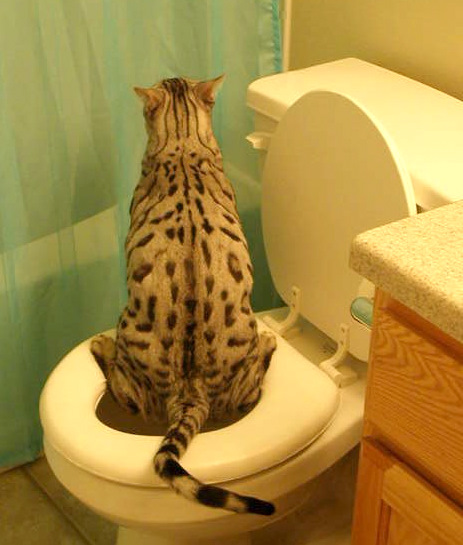Are you currently interested in info concerning Can You Flush Cat Poo or Litter Down the Toilet??

Introduction
As pet cat owners, it's necessary to be mindful of how we deal with our feline buddies' waste. While it may seem hassle-free to purge feline poop down the toilet, this practice can have destructive repercussions for both the environment and human wellness.
Alternatives to Flushing
The good news is, there are safer and a lot more liable methods to throw away cat poop. Consider the complying with choices:
1. Scoop and Dispose in Trash
The most usual method of disposing of pet cat poop is to scoop it into an eco-friendly bag and toss it in the garbage. Make sure to utilize a devoted litter inside story and take care of the waste promptly.
2. Use Biodegradable Litter
Choose biodegradable pet cat litter made from materials such as corn or wheat. These litters are eco-friendly and can be securely gotten rid of in the trash.
3. Bury in the Yard
If you have a yard, consider hiding feline waste in a designated location away from veggie gardens and water sources. Make sure to dig deep sufficient to prevent contamination of groundwater.
4. Install a Pet Waste Disposal System
Purchase a pet waste disposal system especially made for feline waste. These systems make use of enzymes to break down the waste, reducing smell and environmental impact.
Health and wellness Risks
Along with ecological worries, flushing pet cat waste can additionally position wellness dangers to humans. Cat feces may consist of Toxoplasma gondii, a parasite that can trigger toxoplasmosis-- a potentially severe health problem, specifically for expectant females and individuals with damaged body immune systems.
Ecological Impact
Flushing pet cat poop introduces harmful microorganisms and bloodsuckers right into the water, posturing a significant threat to water ecological communities. These contaminants can adversely influence marine life and compromise water high quality.
Final thought
Accountable animal possession expands beyond offering food and sanctuary-- it also involves proper waste administration. By refraining from flushing cat poop down the bathroom and choosing alternate disposal methods, we can lessen our environmental impact and safeguard human health.
Why Can’t I Flush Cat Poop?
It Spreads a Parasite
Cats are frequently infected with a parasite called toxoplasma gondii. The parasite causes an infection called toxoplasmosis. It is usually harmless to cats. The parasite only uses cat poop as a host for its eggs. Otherwise, the cat’s immune system usually keeps the infection at low enough levels to maintain its own health. But it does not stop the develop of eggs. These eggs are tiny and surprisingly tough. They may survive for a year before they begin to grow. But that’s the problem.
Our wastewater system is not designed to deal with toxoplasmosis eggs. Instead, most eggs will flush from your toilet into sewers and wastewater management plants. After the sewage is treated for many other harmful things in it, it is typically released into local rivers, lakes, or oceans. Here, the toxoplasmosis eggs can find new hosts, including starfish, crabs, otters, and many other wildlife. For many, this is a significant risk to their health. Toxoplasmosis can also end up infecting water sources that are important for agriculture, which means our deer, pigs, and sheep can get infected too.
Is There Risk to Humans?
There can be a risk to human life from flushing cat poop down the toilet. If you do so, the parasites from your cat’s poop can end up in shellfish, game animals, or livestock. If this meat is then served raw or undercooked, the people who eat it can get sick.
In fact, according to the CDC, 40 million people in the United States are infected with toxoplasma gondii. They get it from exposure to infected seafood, or from some kind of cat poop contamination, like drinking from a stream that is contaminated or touching anything that has come into contact with cat poop. That includes just cleaning a cat litter box.
Most people who get infected with these parasites will not develop any symptoms. However, for pregnant women or for those with compromised immune systems, the parasite can cause severe health problems.
How to Handle Cat Poop
The best way to handle cat poop is actually to clean the box more often. The eggs that the parasite sheds will not become active until one to five days after the cat poops. That means that if you clean daily, you’re much less likely to come into direct contact with infectious eggs.
That said, always dispose of cat poop in the garbage and not down the toilet. Wash your hands before and after you clean the litter box, and bring the bag of poop right outside to your garbage bins.
https://trenchlesssolutionsusa.com/why-cant-i-flush-cat-poop/

I'm very interested in How to Dispose of Cat Poop and Litter Without Plastic Bags and I hope you enjoyed the new entry. Are you aware of another person who is intrigued by the topic? Do not hesitate to share it. We recognize the value of reading our article about How to Dispose of Cat Poop and Litter Without Plastic Bags.
Call Today